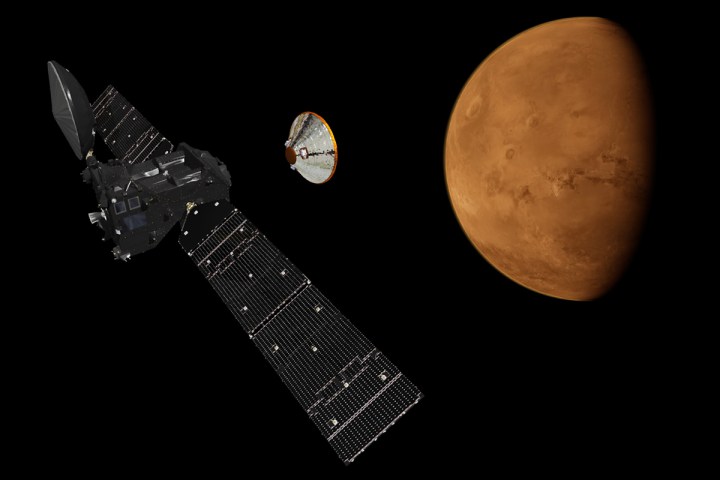
Mission Objectives
The ESA has two primary goals for the ExoMars mission. First, the agency is using the mission as a test to develop technology that will be useful to future Mars landings. Second, the scientist help to find and measure a detectable level of methane and other gasses that are indicators for biological life and active geological processes.
Trace Gas Orbiter (TGO)
As its name implies, the Trace Gas Orbiter (TGO) spacecraft is designed to detect and measure trace gasses in the Martian atmosphere. It will circle the planet for the next four years in an elliptical orbit that is 400 kilometers above the surface of the planet. During this time, the TGO will deploy cutting-edge instrumentation capable of detecting atmospheric components such as methane, water vapor, nitrogen oxides, acetylene, and more. These latest instruments are extremely sensitive, providing data that is three times more accurate than previous measurements. The TGO also will monitor seasonal changes in atmospheric gas composition and temperature changes, allowing scientists to develop a detailed atmospheric model for the red planet.
Though its focus is the atmosphere, the TGO will point its instruments toward the planet below in a study that will map subsurface hydrogen located up to one meter below the surface of the Mars. This data will be used to identify pockets of water and ice hidden below the surface. These areas may help scientists choose safe landing spots for future missions as well as discover underground sources of the trace gasses found in the atmosphere. Lastly, the TGO will function as a point of contact for telecommunications between the Schiaparelli Mars lander during its descent and the arrival of the ExoMars rover in 2020. The mission for the TGO will end in 2022 after the spacecraft sends it final data from the ExoMars rover.
Schiaparelli Mars Lander
Unlike the TGO, which is designed for scientific study and telecommunications, the Schiaparelli Mars Lander is the ESA’s guinea pig. Its primary mission is to test the technologies that the agency has developed for its Mars missions. These technologies include the module’s outer exoshell thermal protection, the parachute system that will slow the module as it descends, the radar Doppler altimeter that will keep track of the module’s altitudes during descent, and the liquid propulsion thrusters that will put on the brakes on the descent and allow the module to land with a gentle bump and not a crash.
As the lander begins its descent into the Maritan atmosphere, several instrumentation packages will be collecting data on how the module is handling the extreme conditions it will encounter on its way down. The Atmospheric Mars Entry and Landing Investigations and Analysis (AMELIA) will monitor the spacecraft’s engineering sensors during descent to collect atmospheric data, while the Combined Aerothermal and Radiometer Sensors Instrument Package (COMARS+) will measure the pressure, surface temperature and heat flux on module’s outer surface. There is also a descent camera that will capture the landing surface as well as images of the atmosphere from a variety of altitudes.
If it lands successfully, the Schiaparelli module then will be used for surface data collection, but only on a limited scope. The Schiaparelli lander does not have a long-term power source and can only operate using the short-term power supply provided by the module’s single-use batteries. Because of size constraints, the module only has a small set of scientific sensors and instrumentation that will take measurements for two to eight sols (Martian days) once on the surface. During its first and only week, the lander will use its surface payload Dust Characterization, Risk Assessment, and Environment Analyzer on the Martian Surface (DREAMS) instrumentation to measure wind speed, wind direction, and surface temperature. The DREAMS package also is capable of measuring surface electrical fields and how they interact with surface dust so scientist can learn more about Martian dust storms.
Once the Schiaparelli module runs out of power, the surface data collection will come to a quick end. Its work will be done but the lander will not be forgotten as it is equipped with laser retroreflectors that make it easy for future Mars spacecraft to locate the module as needed.
Editors' Recommendations
- European Space Agency suspends joint Mars mission with Russia
- Watch the European Space Agency test its Mars rover parachute
- See spring arriving on Mars in these ExoMars images
- Trace Gas Orbiter spots unexpected gases in Martian atmosphere
- She lived in a simulated Mars habitat for four months. Here’s what she learned




